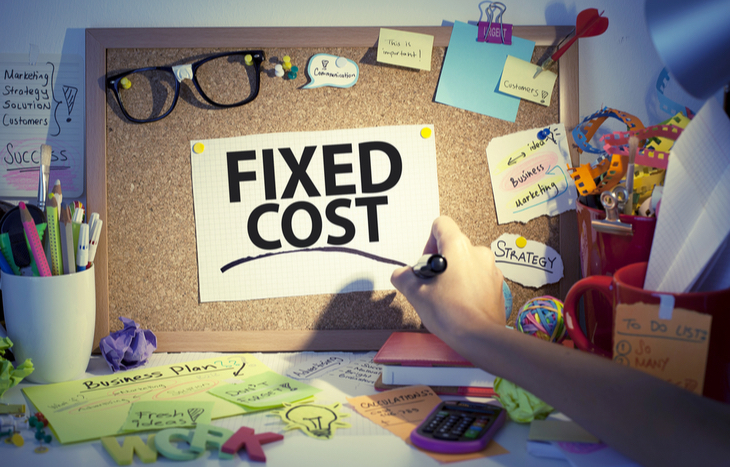What is a Fixed Cost?
So many of a business’ costs fluctuate based on operations. For example, the more products you make, the more you’ll spend on materials to make them. However, there are several important costs that recur again and again, that are ever-constant. These are fixed costs: costs that don’t change with the increase or decrease of goods or services produced or sold.
Typically called overhead costs, fixed costs are part of a company’s broader business expenses. They’re important because they’re unchanging and represent the company’s short-term obligations to stay operational. If you can’t pay your monthly rent, you can’t keep the business running! And, monthly rent stays the same, regardless of how much revenue you bring in.
Aside from rent, businesses can have a variety of overhead expenses to consider. These costs show up on the balance sheet as liabilities. Fixed costs are an important factor to consider when evaluating the overall financial health of a business—especially its cash flows.

Fixed vs. Variable Costs
Fixed costs are not factored into cost of goods sold (COGS). They’re tabulated independent of products and services produced and sold. The company is responsible for these fixed costs on an ongoing basis, regardless of company performance or other cash flow indicators. From an accounting standpoint, these are indirect costs of production.
Variable costs change in tandem with production because they’re related to the product or service. They’re factored into COGS, which influences how much a business needs to charge to maintain profitability on each unit sold. They can occur in tandem or inversely. For example, the total cost of materials will rise as a company produces more units, but the price of materials may fall as the quantity needed goes up.
Together, fixed and variable costs represent the business’ total expenses: its liabilities. They’re the cash outflows a business spays to sustain operations.
Examples
Companies can carry a variety of fixed costs depending on the size and nature of the business. Some of the most common fixed costs include:
- Rental leases and mortgage payments
- Business insurance premiums
- Property tax payments
- Interest expenses
- Budgeted or prorated utilities
- Asset depreciation
As businesses grow, fixed costs tend to grow. Larger production demands require more factory space or the more employees the business has, the higher its insurance premiums.
It’s important to note that while these fixed costs may increase, what keeps the “fixed” is the consistency of the payment itself. For example, if the business leases 50,000 square feet for $60,000 annually, its monthly lease expense is $5,000. However, if the company grows and leases another 25,000 square feet for an additional $30,000 annually, it can expect its monthly payment to climb an additional $2,500 per month.
The Role of Fixed Costs in Economies of Scale
Economies of scale are an important business concept. They represent a business’ ability to produce and sell more goods, while staying cash flow positive. Because fixed costs don’t change, they represent a breakeven point: the baseline level of expenses that a company must cover. That means as production and sales ramp up, companies are able to pay their fixed costs and reach profitability sooner.
Say, for example, that a company has $5,000 in fixed costs each month. It sells Widgets for $200 at a profit of $100 on each unit. It needs to sell 50 Widgets each month to break even. Now, say that the company ramps up its sales and is now able to sell its $200 at a $120 profit, because it gets a bulk discount on materials. Fixed costs remain the same; however, the company breaks even at a sale of 42 Widgets.
It’s important to realize that fixed costs and economies of scale can be offset at certain points. For example, if ABC Company leases a Widget factory for $10,000 per month and produces 10,000 Widgets per month, the cost of the least per unit comes out to $1. However, if 10,000 units is the factory’s maximum output, increased production will require another factory. The cost of the second lease will drive up the per-unit cost spread until the business achieves a new economy of scale.
What is a Sunk Cost?
The definition of a sunk cost is an unrecoverable expense. In the same way that all rectangles are squares but not all squares are rectangles, all sunk costs are fixed costs, but not all fixed costs are sunk costs. A fixed cost becomes a sunk cost only once it’s unrecoverable. For example, a business can’t recoup a lease payment for the previous month it occupied a building. A fixed cost that’s recoverable is not a sunk cost. For example, if the business buys a vehicle and there’s a defect, it can return the vehicle for a refund.
Coming to Terms With Fixed Costs
Fixed costs are the cost of doing business. You can’t manufacture a product without equipment and a factory. The good news for businesses is that these costs are known. Unlike variable costs that can change continuously, fixed costs provide an easy benchmark for breaking even. Understanding fixed costs and what they represent allows businesses to better-understand operations and build economies of scale.
For investors evaluating businesses, knowing fixed costs is important in understanding the company’s cash flows and balance sheet. To learn more, sign up for the Liberty Through Wealth e-letter below. You can learn how making smart investments can help you build wealth in your life.
Fixed costs aren’t inherently bad—it’s all about what they represent and how the company uses its capital assets to generate revenue. Often, fixed costs are a small price to pay for strong revenues.





